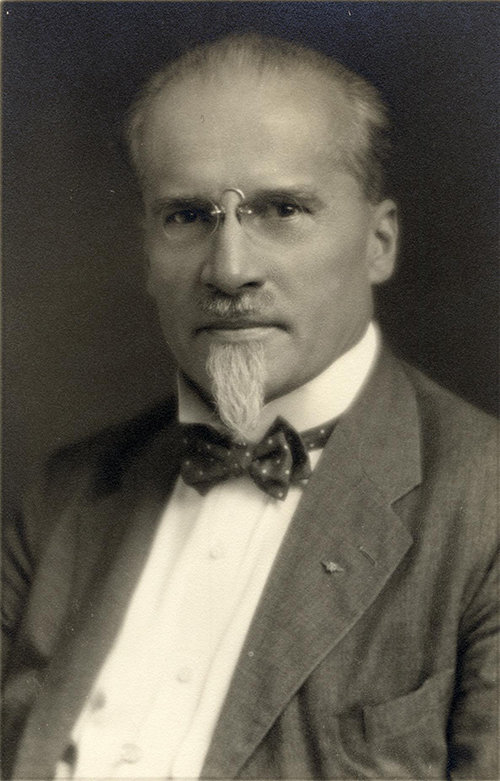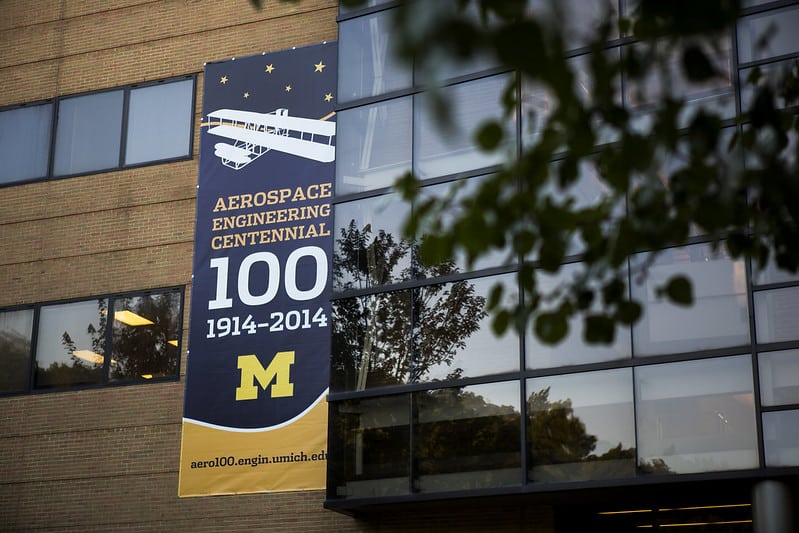
History
The Department of Aerospace Engineering has been an integral part of the College’s tradition of quality. The department was borne out of the nation’s first collegiate aeronautics program, begun at Michigan in 1914, just 11 years after the historic flights at Kitty Hawk.
The first course was taught by Felix Pawlowski, who had been a student of Professor Lucien Marchis at the University of Paris, in the first aeronautics course given anywhere. In offering aeronautics at Michigan, Pawlowski was building on interest created by Professor Herbert Sadler, who had recently reorganized the Michigan Aero Club. Both Pawlowski and Sadler had seen the Wright brothers and other aviation pioneers; and the enthusiasm of these two teachers would be the driving force behind aeronautics during its first years at Michigan.
First courses

Under the direction of Pawlowski, the first courses at the University, proved to be so popular that it was necessary to extend and correlate them as one of the regular group of electives. These courses, however, were for members of the Aero Club and were offered without credit. A translation of Duchene’s Flight Without Formula was used as a textbook. The regular courses in aeronautical engineering were organized as a group of electives in the Department of Naval Architecture and Marine Engineering, and only junior and senior engineering students were eligible.
In 1915-16, additional courses in aeronautics were added: Propulsion of Aeroplanes, which dealt with propeller and motor design, and Aeroplane Design, which consisted of lectures and drawing work. The details of the actual construction of an airplane were discussed and a design was made. Only sixteen students were enrolled in these courses.
In 1916-17, a complete four-year program was arranged. In May, 1917, the degree of bachelor of science in aeronautical engineering was established, and in June 1917, William Frederick Gerhardt became the first student to receive it.
The early years of the Department of Aerospace Technology were filled with daring experimentation in balloons, gliders and, when available, powered airplanes, including a model “B” hydroplane built by the Wright brothers.
Research
Research became increasingly important in the development of the department. A wind tunnel was built in 1926 after Pawlowski visited Europe and obtained information to aid in its installation. The wind tunnel was used to conduct tests for industrial concerns, and a study of the downflow of gases behind power plant gas stacks was one experiment they conducted. Other experiments were carried out as a result of the acquisition of a multiple-tube manometer and a darkroom for photographic work. New equipment was acquired as the need for it arose. For example, a suction blower and auxiliary equipment were installed to test the resistance of automobiles by streamlining. With the aid of Civil Works Administration labor in 1933-34, a propeller dynamometer, a small portable smoke tunnel and dynamic stability dynamometer were completed. In 1934, a small wind tunnel was constructed with the aid of Federal Emergency Relief Administration and National Youth Administration labor.
Research began on the application of magnesium to aircraft structures. The department co-operated with the Dow Chemical Company in producing a wing Model SNJ-1 airplane for the Bureau of Aeronautics. This was the first magnesium aircraft structure to demonstrate a definite weight saving over the corresponding aluminum alloy structure.
Airplane model tests were conducted for the Ford Motor Company and the Lee Wendt Company of Chicago; wind pressure and rain penetration tests were carried out for the Celotex Corporation of Chicago; and an investigation of the pressure distribution over a steel hut for Army use was completed for the Stran Steel Division of the Great Lakes Steel Corporation. Several confidential projects were undertaken for the Army Air Corps in conjunction with the Engineering Research Institute.
The Department Grows
These experiments in flight, the research on airplane designs, and the basic course work were all marked with camaraderie and a shared commitment to expanding the knowledge and possibilities of this exciting new field. The Department grew quickly in scope, enrollment and stature. Graduates of the program distinguished themselves as pilots, designers, industry leaders, and as government officials in new agencies established to promote and regulate aviation.
One graduate became a legend. Clarence “Kelly” Johnson (B.S.E. ’32, M.S.E. ’33) is considered to have been one of America’s greatest aircraft designers. In 1933, Lockheed sent its model of one of the world’s first twin-engine aircraft, the Electra, to Michigan for review. Johnson tested it and found instabilities in the aircraft. He was later hired by Lockheed and went on to establish the legendary Lockheed Skunk Works and create such classic aircrafts as the P-38, the F-104, the U-2, and the SR-71 Blackbird during his 40-year career. (Read more about Kelly Johnson and Skunk Works.)
In the years since Kelly Johnson was a student, the size and focus of the Department have changed in response to economic conditions, the exigencies of war, and advances in the field; but one constant has remained: quality. Just one example of this quality can readily been seen in manned space exploration. Among the Aerospace Engineering Department’s prominent alumni are five astronauts who have orbited the earth, with three going on to the moon. During the Gemini program, Ed White, who later died in the Apollo launch pad fire, made the first spacewalk by an American. Other Michigan astronauts include Jack Lousma, who commanded Skylab and piloted the third space shuttle flight; James McDivitt, commander of Apollo 9; and James Irwin and Alfred Worden of Apollo 15. The Michigan mementos (including the seal of the Department) placed on the moon by the Apollo 15 crew are fitting symbols of the impressive achievements of the people who have been part of the Department’s first 100 years.
Celebrating a century of Aerospace
2014 was a big year for the Aerospace Engineering department – it marked a hundred years since the first classes in aeronautical engineering were held at the University of Michigan, kicking off the nation’s first undergraduate program in the subject.
View the recorded panel discussions and presentations from the Centennial Celebration that took place September 18th-20th, 2014.
History of the department informational PDFs
Aero Course Listings 1947-1985
CICE Course Listings 1971-1984
IE and ICE Course Listings 1959-1968
AEROSPACE CENTENNIAL
department’s history through our distinguished alumni and faculty, as well as insights into the future of aerospace.
